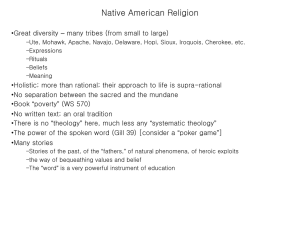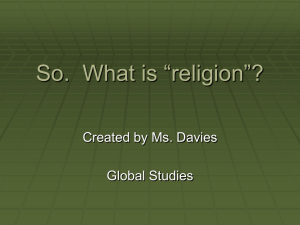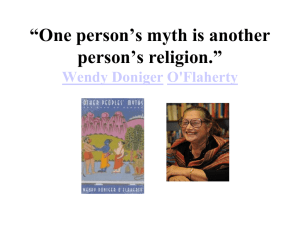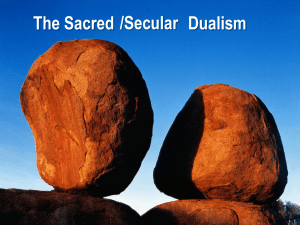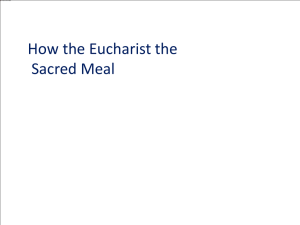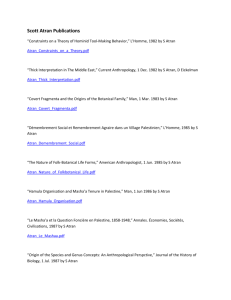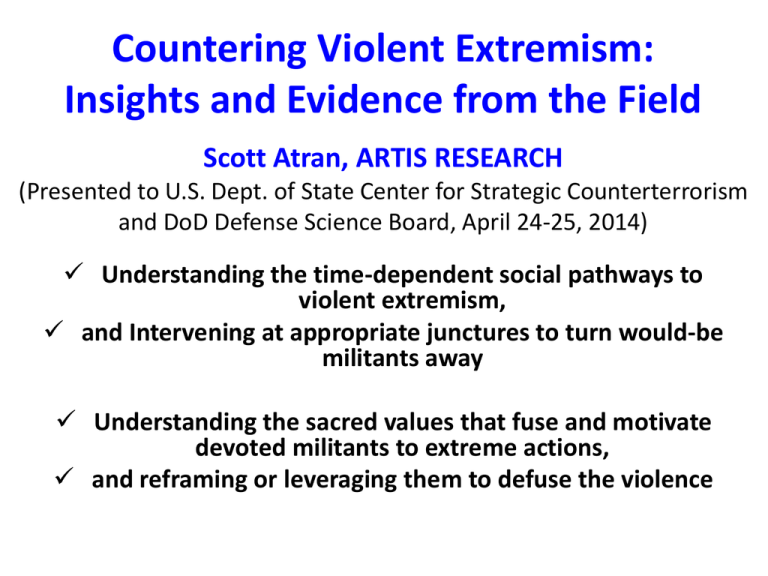
Countering Violent Extremism:
Insights and Evidence from the Field
Scott Atran, ARTIS RESEARCH
(Presented to U.S. Dept. of State Center for Strategic Counterterrorism
and DoD Defense Science Board, April 24-25, 2014)
Understanding the time-dependent social pathways to
violent extremism,
and Intervening at appropriate junctures to turn would-be
militants away
Understanding the sacred values that fuse and motivate
devoted militants to extreme actions,
and reframing or leveraging them to defuse the violence
Devoted Actor - Sacred Values
DoD – MINERVA (AFOSR – ONR) Research Team
• Scott Atran (ARTIS, Oxford University, CNRS-Ecole Normale Supérieure,
John Jay College - CUNY, University of Michigan)
• Richard Davis (ARTIS, Oxford University)
• Lord John Alderdice (ARTIS, Oxford University)
• Jeremy Ginges (ARTIS, New School for Social Research, Melbourne U)
• Robert Axelrod (ARTIS, U Michigan)
• Douglas Medin (ARTIS, Northwestern U)
• Baruch Fischhoff (ARTIS, Carnegie Mellon)
• Juan Zarate (ARTIS, Center for Strategic & International Studies)
• Lydia Wilson (ARTIS, Cambridge University, Graduate Center, CUNY)
• Hammad Sheikh (ARTIS, John Jay College, CUNY)
• Sonya Sachdeva (Northwestern U.)
AFOSR-Minerva PI Lawrence Hirschfeld ( New School for Social Research)
ONR-Minerva PIs Arie Kruglanski & Michele Gelfand (U Maryland)
2
Intractable Conflicts, Revolutions,
Terrorism
Our multidisciplinary team working in conflict
zones around the world has been exploring why
people decide to refuse political compromise, go to
war, attempt revolution or resort to terrorism.
Field Sites:
Lebanon, Israel/Palestine, Syria, Pakistan, India,
Turkey, Indonesia, Egypt, Morocco, Spain,
France, N. Ireland, Guatemala, Mexico, Chile
Devoted Actors & Sacred Values
The General Framework:
• Uncompromising wars, revolutions and terrorism are driven by
Devoted Actors who adhere to sacred or transcendent values that
drive actions independently, or all out of proportion, from
rationally expected outcomes, calculated costs and consequences,
or likely risks and rewards.
• Devoted Actor Hypothesis: When sacred values become
embedded in fused social groups, then members of these valuedriven groups become willing to collectively defend or advance
those values through costly sacrifices and extreme actions, in ways
resistant to material tradeoffs and normative social influence.
How we proceed:
1. Interviews with political & military
leaders, supporters and would-be
warriors to generate hypotheses,
2. followed by lab experiments to test
plausibility,
3. then experimentally designed
surveys to test real-word reliability.
Importance of Field Studies
A main problem in studies of violent religious and political
extremism is that most “experts” have little field experience and
otherwise lack the required level of details that statistical and
trend analyses could properly mine.
There are many millions of people who express sympathy with
forms of violent political expression that support terrorism. There
are, however, only some thousands who show willingness to
actually commit violence.
They almost invariably self-select and go on to violence in small
groups of volunteers consisting mostly of friends and some kin
within specific "scenes": neighborhoods, schools (classes,
dorms), workplaces, common leisure activities (soccer, mosque,
barbershop café) and, increasingly, online chat-rooms.
We have to get into these scenes to know how to stop them.
Who are the most active terrorists?
• Global AQ is a viral, social movement and political ideology, not a
well-organized operational structure with command and control.
• At this point, the most active and dynamic terrorists belong to
spontaneously self-generated, self-organized networks of friends and kin,
who are radicalized collectively and collectively decide to carry out
terrorist operations.
• For the most part, surviving remnants of Al Qaeda don’t know who the
new terrorists are and can’t reliably communicate with those they do
know.
• These loose networks have attempted to carry out operations across the
globe - in Africa, Europe, Asia and North America - on behalf of AQ, but
they are not AQ.
• Retrospectively, AQ has accepted them into its spiritual fold.
• The global jihad’s principal enlistees today are youth in transitional
stages in their lives: students, immigrants, between jobs or girlfriends,
having left their genetic family and searching for a new
“brotherhood,” petty criminals who don’t want to be criminals, etc.
Decentralized Jihad
• Under a decentralized regime, small groups engage in resistance or violent activity
independently without central coordination. Leadership figures provide inspiration
to members and affiliated organizations - however, jihadis enlist and engage in
terrorist activity without necessarily consulting leadership.
• International success at stopping large transfers of money to terrorist organizations
have compelled the new wave of terrorists to seek financing where they can, and so
many operations nowadays ride piggy-back on available petty criminal networks.
(9/11 cost > 400,000, followed by Bali and Madrid bombings at about $50,000 a
piece; all others less).
• Most significantly: marginalized Muslim youth who become petty criminals
because of « opportunity costs », who then get involved in aiding jihadis, often
enlist into violent jihad because of the promise of achieving a great sense of
personal significance in a glorious cause – and it is these young people, even
more than the ‘ideological’ students and others, who prove themselves most
ready to kill and die.
Bureaucratic Mirroring
• Notions of COMMAND & CONTROL via
“cells,” “recruiters,” “hierarchy,” and
“brainwashing”
• thus reflect more the psychology and
organization of people analyzing terrorist
groups than terrorist groups themselves.
Radicalization:
From Political Protest to Violent Extremism
Stage 1. The Protest SCENE (perceived political and social
injustice resonates with personal experiences, channeling
personal frustrations into moral outrage)
Stage 2. Call to MILITANCY and DEFENSE of SACRED
VALUES that define Collective Identity.
Stage 3. Breakaway with friends and fellow travelers into
a PARALLEL UNIVERSE (withdrawal into a mental and
physical cocoon, whose members hype one another up).
Stage 4. Linking Up to a VIOLENT MOVEMENT.
Stage 5. Planning and Executing Violent ACTION.
A Probable Pathway to Stage 2 Radicalization:
Evidence from Morocco (Tetuan & Casablanca, 2014, N=260)
- Self-reported religiosity increased support for violent extremism (militant jihad and
martyrdom) and anti-democratic attitudes (postponing elections for implementing Sharia)
via religious fundamentalism (i.e., Salafist, literalist, Islam only true religion, etc., α = .83)
- The relationship between religiosity and religious fundamentalism is amplified by Sharia’s
sacredness, while the relationships between religious fundamentalism on one hand, and
violent extremist attitudes and anti-democratic attitudes on the other, are amplified by
group exceptionalism (i.e., my group is special, better, unappreciated, etc., α = .82 )
The Nuanced Role of Education in Radicalization
Education intervenes in two different places in the pathway to extremism.
1. First, it dampens the link between religiosity and religious fundamentalism. This finding
is in line with the salutary conception of education in the context of political conflict.
2. However, education also may be exacerbating the link between religious
fundamentalism and anti-democratic attitude, as people may become even more antidemocratic when also highly educated (e.g., the doctors and engineers of Al Qaeda).
How to Deal with Radicalizing Youth ?
- in transitional stages in their lives,
- who are increasingly less educated,
- less economically well-off,
- and less socially stable
The New Wave of Terrorism is about “Youth
Culture,” JIHADI COOL, not the Koran
•
You don’t influence youth culture by asking community elders to spout off messages
about the Koran (negative messages by adults have a negative impact on youth attitudes)
– for example, cigarette consumption among youth increases in anti-tobacco campaigns
that emphasize bad things)
•
The Koran is almost irrelevant (though it’s cool if someone in the peer group or an elder
brother can read Arabic and spout it off).
•
How you change youth culture is a difficult and fickle affair. But role models or small
changes often have big effects on attitudes and fashions (gangsta culture, skateboarding,
post-Madonna belly-button exposure, hush puppies fad).
•
The key, however, is providing alternate social pathways and networks that will allow
young people to achieve a sense of personal significance in a glorious cause that they can
share with an “imagined family” – a Brotherhood of friends and fellow travelers
Defusing Small-Scale Social Networks
Preliminary research indicates that pulling people out of their fused
networks devoted actors and companions is most likely to allow
desacralization of ideological values for individuals.
- New York City police refer to “PRISLAM” as the phenomena whereby
people become radicalized to Islam in prison (often to better form
trusted groups to fend off threats from other gangs); but when
radicalized prisoners are released they go back to communities that
hold little support for radical Islam and so the radical ideas fade.
- In Europe, however, where the prison population can be
overwhelming Muslim and where marginal Muslim immigrant
communities, petty criminal networks are increasingly involved with,
and influenced by, radical Islamist teachings as a way of:
- De-marginalizing through action in a glorious collective cause that
provides personal significance through collective commitment
Wrong-Headed “Common Sense” & Cost-Benefit
Approaches to Fully Radicalized Jihadis
•
Classic Military and Counterterrorism strategies. For example:
– Quadrennial Defense Review: “Minimize” U.S. costs in lives & treasure, while
imposing unsustainable costs on the enemy”
•
To a significant degree, Jihadis don’t respond to a utilitarian cost-benefit strategies
(airport plotters knowingly chose the targets most watched; Ulm plotters in Germany
knew they were being watched and flaunted this knowledge; European volunteers for
Syria are up front about readiness to die).
•
They respond to moral values, and are more than willing to die for the cause.
•
Each death inspires many more young Muslims to join the cause.
•
Utilitarian perspectives (offers of jobs, housing money) often play into the hands of
terrorists: U.S. and allies try reduce peoples to material matter rather than moral
beings.
•
Tsunami relief a good example of what works (but intermittent, not sustained).
USAID programs too spotty, short-term for “Long War.”
A New Wave of “Rejectionist”, or Takfiri, Terrorism
• After 9/11, a newer wave of Takfiri terrorism has emerged
(for the most part opposed by strict Salafi schools)
• Proponents are generally less educated, economically and
socially more marginal, and even younger than those of the
earlier wave.
• They became sensitized - through videos, cable television,
internet - to belonging to a world underclass of true
Muslims, oppressed by a godless or immoral ruling class.
• They have begun trying their own hand at emulating their
media heroes who had « brought down » the Soviets and
« inflicted pain » on America.
Al Qaeda’s 3 Waves:
increasingly younger, less skilled, less educated
( data from our Southeast Asia database)
Al Qaeda’s 3 Waves -- Education
Kingdom of Saudi Arabia
Ministry of Interior
The Saudi Experience
of Countering Terrorism
Background - Takfiri Ideology
Al-Jammah al-Islamiyah
Al-Jihad group
Pakistan
Global
Egypt
Afghanistan
Strategy
Our efforts to successfully counter terrorism
focus on three key issues:1- The men.
2- The money.
3- The mindset.
Recruitment and Radicalization
process
Identification of targets
Places of recruitment
1.
2.
3.
4.
Mosques
Schools and universities
Neighborhood
Social activities
(religious lectures,
visiting relatives etc..)
5. Camping
6. Internet especially chat
rooms
1.
2.
3.
Dialogue
Friendship
Gain his trust by
addressing and fulfilling
his needs and desires
Persuasion
1.
2.
3.
4.
Isolation
Glorifications of violent
jihad
justifications
Trapping and scaring
Involvement in terrorist
activities
Means of persuasion
1. Audio and video tapes.
2. Books about politics and jihad.
3. Extremist preacher.
4. Lectures.
5. websites etc…
1.
2.
3.
4.
Training
Fundraising
Facilitation
Active participation
The Mindset
How radicals use the internet
•
•
•
•
•
Data collection.
Recruitment.
Propaganda/psychological war.
Fundraising.
Operations (planning, executing,
communicating, training…etc.).
Response - Strategic
•Restructuring command, control, and
communications.
•Allocating more resources to combat terrorism.
•launching campaign to counter the takfiri
ideology.
•Monitoring financial transactions.
•Rehabilitation program for detainees and
families.
The Mindset
De-radicalization
Our rehabilitation program targets detainees (2779) in
the following areas:1- Religious:
• religious study sessions
• one on one dialogue
2- Psychological and social:
• psychological evaluations
• Support family financially and morally
3- Media:
• provide information to the public
• production of media programs
4- Security
The Mindset De-radicalization
follow up phase:
•
•
•
•
Staying in touch.
Supporting released detainees (to adapt).
Assisting with employment and marriage.
Involving families in the rehabilitation
process.
• Radicalization processes are most often friendship based,
but the dynamics are different from society to society
- For example, in UK universities Muslim students fell
uncomfortable with liberal drinking and sex
- They may be invited to a social mixer or barbecue where
young Muslims can meet and discuss their personal
experiences and problems
- After a few meetings the talk may be steered to grievances
at home and abroad that jihadis seek to address
- Most present will ignore these feelers, or fall out from the
informal group, but one or a few might stay
And then…
De-Radicalization Programs
•
Saudi: partly successful, very expensive and labor intensive, involves strong pressure on families –
programs not readily exportable to other countries.
•
Indonesia: Counterterrroism intelligence and police treat the problem as a public health issue more
than simply a criminal issue and turning militants and their family networks into deradicalizers by
offering clemency and family support -- incompatible with current reliance on criminal justice in
American, European, Russian and Chinese contexts. (Note: Gen Doug Stone used this approach to
successfully depopulate Abu Ghraib prison).
•
Turkey: National police also treat problem as public health issue; Don’t ask where people with
known contact to jihadis in Afghanistan, Pakistan, etc. been and who they know as long as no act
committed on Turkish soil, but let families know that police are watching close, yet will provide
family support (jobs, favors, etc.) if the families monitor and take care of their own – very successful
with potential jihadis, less so with Kurds (because less directly engaged at community level).
•
UK: Metropolitan police are bringing in people from immigrant communities at risk as police agents,
including former troubled youth with petty criminal records; good cooperation with NYPD, which has
provided a role model for successful at community-based policing of potential jihadis and plots
(despite the recent negative publicity suggesting otherwise).
•
Guatemala: Law enforcement and gov’t readily corrupted by narco payoffs, and communities
pacified by large-scale infusions of narco funds; Zetas and other gang-like groups also control prisons
-- narco competition mitigates any incentive to move away from violence, if such incentives existed
(they don’t) – Us counterterrorism (anti-narc) strategy here is largely ineffective.
“Knowledge of the interconnected networks of
Afghan Alumni, friendship, kinship and marriage
groups was very crucial to uncovering the inner
circle of Noordin.”
~ Gen. Tito Karnavian, head of Indonesian police strike
team that tracked down Noordin Mohammed Top
(personal communication, December 10, 2009)
Noordin’s Networks, June-September 2009
Ismail
Paranto (Urwah)
Baradin
Latif
Rahayu
Dwi Astuti
Noordin
Top
Hermawan
Susanto
Daroni
Mujiono
Syaefuddin
Zuhri (Sabit)
Ariana
Rahman
Utomo
Moh. Zuhri
Tataq
Utami
Ibrohim
Sulistioni
Mohamad
Sjahir
Suryana
Setyawan
LEGEND
Jaelani
REGIONAL
GROUPINGS:
Amir
Ibrahim
Purwanto
Sarjono
Bekasi
Network
Weak Tie
Medium Tie
Family Tie
Dead
Eri
Kadawarti
Dani Dwi Nana Ikhwan
Maulana
Permana
Widodo
Temanggung
Network
Arrested
As-Surur
Cilacap
Network
Suicide Bombers
Free
Whereabouts
Unknown
Hamas al-Jihad Soccer team (family and friends):
Most sustained suicide attack campaign of 2nd Intifada and Beyond
Hamas poster of Dimona (Feb. 08) suicide bombers:
“Martyrs” Mohammed Herbawi (left) and Shadi Zgyaer (and “the enemy,”
Russian immigrant Lyubov Razdolskaya
The Madrid Bombing and its Aftermath:
« Organized Anarchy »
• The Madrid bombing, by a bunch of radical students
and hangers on, drug traffickers, small-time dealers in
stolen goods and other sorts of petty criminals,
improbably succeeded precisely because it was most
improbable.
• There was no ingenious cell structure, no hierarchy, no
recruitment, no brainwashing, no coherent organization.
• Yet this half-baked plot, concocted in a few months,
with a target (probably) suggested over the internet, was
the proximate cause of regime change in a democratic
society.
The Jamaa Mezuak Connection:
After the Madrid plotters from Mezuak blew themselves up (April 3, 2004),
friends in the neighborhood began contemplating their own “matyrdom
actions” in Iraq (beginning in summer 2006)
Scene below Al Rohbane Mosque where kids play soccer and « Jihad » (the
way we used to play « war » with sticks and stones)
It is important to provide alternative dreams (of significance and
glory) and heroes in primary & secondary schools (e. g, sports)
[Below: Children from the elementary school in the Jemaa Mezuak
Neighborhood of Tetuan, Morocco, attended by 5 of the 7 Madrid
bomb-plotters who blew themselves up]
Choice of Role Models for Youth in Palestine, 2012
(Positive role model = max +3, Negative role model = max -3)
Top-Down Networks (Hierarchies) vs.
Bottom-Up Networks
• Top-down networks – including hierarchies as in most
government, military and law enforcement organizations - are
more efficient in targeted planning and execution of particular
tasks.
– They are also more amenable to legal and moral control in terms of
accountability and responsibility.
• Bottom-up networks are more efficient at rapid adaptation to
ever changing conditions.
– They are more able to innovate, but also more susceptible to
infiltration and disruption.
• Criminal networks (like Mafia or some drug “cartels”)
overcome this limitation by establishing reliable relations of
trust mostly through kinship, friendship, apprenticeship.
Terrorist Networks Motivated by Moral Cause
• Some Terrorist Networks have the added
incentive of commitment to a moral cause,
which allows for greater sacrifice than is usually
possible with typical reward structures based on
material incentives (regular police, army).
• Devotion to a moral cause is not a network
property, but in some Terrorist Networks, as with
revolutionary movements generally, this allows
resource-deficient movements to survive, and
eventually triumph, against much stronger
material forces.
Sacred Values
KEY ISSUES:
–When do sacred values instigate or
sustain violence?
–To what degree?
–How can SVs be leveraged to stop
or reduce intergroup violence?
Sacred Values vs. Material Calculus
Much more is known about economic decision making
than morally-motivated behavior. But here are some
empirical features of SVs that we have been testing:
•
•
•
•
•
•
Insensitive to quantity
Immune to material tradeoffs
Insensitive to Framing Effects
Privileged link to emotions
Generate actions independent of prospects
for success
Have distinct neural processing signatures
(fMRI)
Sacred Values & The “Backfire Effect”
Studies with Palestinians, Israeli settlers, Indonesians, Indians,
Afghans and Iranians show that:
offering people material incentives to compromise sacred
values (large amounts of money, promise of a life free of
political violence) can backfire, increasing violent opposition
to compromise.
Backfire effects occur both for sacred values with clear religious
investment (Jerusalem, Sharia law) and those with initially none
(Palestinian refugees’ right of return, Iran’s right to nuclear
capability).
The backfire effect.
Offering material incentives to compromise sacred values increases
anger and violence toward a deal (Atran & Ginges, Science, 2012)
Palestinian Refugee predictions of % of
population ready to use violence to oppose:
a peace deal perceived to violate a collective
moral value (“taboo” condition), the taboo
deal plus an instrumental incentive
(“taboo+”), or the taboo deal plus a
collective moral concession without
instrumental value from the adversary
(“tragic”)
Refugees reporting ‘joy’ at hearing
of suicide bombing
relative to overall mean estimate
(linear trend, F [1, 418] = 7.48, P = .007)
[Ginges, Atran, Medin & Shikaki, PNAS, 2007]
(linear trend: F [1, 195] = 5.698, P = .018)
P r o p o rtio n re p o rtin g jo y a t s u ic id e b o m b in g
.7
.6
.5
.4
t a bo o +
t a bo o
t ra gic
Brain regions identified in which sacred items resulted in greater activation than non-sacred
items (N= 36, P<0.005). These included the left ventrolateral prefrontal cortex (L VLPFC)
and the right amygdala. The statements that resulted in more amygdala activation represent
the most repugnant items to the individual, which is consistent with the idea that when
sacred values are violated they induce outrage
(Berns et al., in Berns & Atran, Phil. Trans. Royal Soc – B, 2012)
You chose:
I Believe in God.
I am an Apple person.
Scale indicates percentage of
people that agree with you
seen by subjects in fMRI
Results: people who hold
sacred values won’t accept
money to renounce them, and
don’t alter commitment to
them in response to what
others may think, but will
accept money and alter
commitment to non-sacred
values
Additional Directions & Experiments on
Sacred Values and Devoted Actors
Insensitivity to:
• Social Influence
• Temporal & Spatial Discounting
• Exit Strategies
Bound to notions of personal and collective identity, of
“Who you are & whom you trust,” especially under
conditions of perceived outside threat.
• Often have a strong communitarian component
•
For example the role of religious rhetoric and ritual in the
sacralization of Iran’s nuclear program (Dehghani, Atran, Iliev,
Sachdeva & Ginges, J. Judgment & Decision Making, 2010)
Devoted Actors are Resistant to Social
Influence: Experimental Conditions
- Control: “Please think about the conflict between
Palestine and Israel today.”
- Ingroup Support: “As you know, Palestinians feel very
strongly about [securing the refugees right to return to
their original lands, towns, and villages / reclaiming
Palestinian sovereignty over their own airspace and
borders].”
- Outgroup Opposition: “As you know, Israelis feel very
strongly [about Palestinians’ right of return and have
rejected it since the creation of Israel / that they need to
deny Palestinian control over the airspace and borders
of Palestine].”
Resistance to Social Influence
Palestine: Right of return v. Sovereignty
(Sheikh, Ginges & Atran, J. Judgment Decision Making, 2013)
- emerging Sacred Value of Sovereignty over
airspace and borders was immune to social
influence only for devoted actors
- established Sacred Value of Right of Return
was immune for everyone
- interesting also because Israeli opposition to
Right of Return is associated with higher costs
for Palestinians
Resistance to Social Influence
Sovereignty
Resistance to Social Influence
Right of Return
Devoted Actors are Resistant to
Temporal Discounting
- negative events (e.g., painful defeats) in the
past will be more motivating (for continued
struggle) when felt to be temporally closer
- similar for positive events (e.g., expected
victory)
- devoted actors may perceive such events to be
closer
Temporal Discounting
Approximately 50 percent of Kurds judged on a scale of 1 to 10 that
Salah ed-Din (the 12th century Kurdish war chief and founder of the
Ayyubid dynasty who recaptured Jerusalem from the Crusaders) felt
closer in time than WWI, the founding of modern Turkey and Iraq,
and other major events 19th and 20th centuries.
Accuracy for recent historical events, was high (e.g., nearly all
informants correctly estimated WWI as > 90 but < 100 years. By
contrast estimates of Salah ed-Din’s ranged from >100 to > 1000
years.
Hypothesis: for defining events in cultural history, there is no
discounting based on actual distance in time, and actual distance in
time may be irrelevant.
Temporal Distance
as a function of Sacred Values
Years Until Return of Palestinians to Homes in Israel
Devoted Actors are Resistant to
Spatial Discounting
• Interviews with mujahedin groups in Sulawesi
(Indonesia)
• Overwhelming preference to fight and die in
Palestine
• How do indigenous people, from a culture
emerging from the Stone Age less than 100
years ago and separated from Palestinian and
Arab peoples and history for close to 50,000
years, suddenly and sincerely want to kill and
die for Palestinians?
Blindness to Exit Strategies
- Devoted actors may feel that their choices are constrained
by their duty to a SV, for good or ill
- They may be more likely to reject individual exit strategies
(e.g., Thermopylae, Masada, “Give Me Liberty or Death!,”
The Alamo, Waffen SS “Death Squads” in Soviet siege of
Budapest, Kamikazi, jihadi suicide bombers)
- Devoted actors are more likely to refuse individual
opportunities to exit the conflict even when these
opportunities would morally serve God or country
Devoted Actors are Blind to Exit Strategies
Palestine Study:
participants were presented two scenarios allowing them
to escape violent conflict
- imagine an invasion by "Israeli invasion forces
and a resistance is being organized."
- Scenario 1: "make a Hajj to Mecca instead of
staying to resist."
- Scenario 2: go "overseas to participate in a
training program so that you can come back and
serve your country."
Those who considered armed resistance a sacred value
refused the tradeoffs, some becoming angry at the offers
How do Devoted Actors convert the General
Population to their SVs?
1. Heightening Threat Perception and Conflict facilitates
sacralization of mundane issues and norms into absolute
values. (Sheikh, Gingis, Coman & Atran, Judgment & Decision Making,
2012; Dehghani et al. JDM, 2009. 2010)
2. Ritualized Displays of Costly Commitment to Apparently
Absurd Beliefs & Behaviors by Devoted Actors leads to
Emulation of, and Trust in sacred and uncompromising
beliefs and behaviors by the General Population (Atran &
Henrich, Biological Theory, 2010; Sheikh, Ginges & Atran, JDM, 2013).
Through these processes, the general population begins to
incorporate SVs as norms, and then internalize them.
In our survey of values, greater attendance in religious services
corresponded with more values held sacred (measured by
refusal to forsake them in an economic game).
In a longitudinal study of Palestinian adolescents, when they
perceived threat to their people, those more involved in
religious ritual (frequent prayer, mosque attendance) were
likelier to see political issues central to conflict as absolute
moral imperatives forbidding Palestinian leaders to
compromise, whatever benefits or costs to their people.
Group interests, especially when threatened, may become
sacralized through alliance to religious rituals and rhetoric, as
with Iran’s nuclear program and disputes over Persian Gulf
Islands. (Sheikh, Ginges, Coman & Atran, J. Judgment & Decision Making, 2012)
What is special about sacred (religious)
frames?
People will not consent to explicitly abandon such a frame
or adopt a new one because moral / religious frames are
bound up with personal and social identity.
But the content of sacred frames (including religious
texts) is open-textured: that is, the meaning of sacred
frames (and the texts upon which they rely) is subject to
reinterpretation.
Re-Prioritizing & Re-Framing Sacred Values
Reprioritizing SVs, Reframing SVs, and willingness to Delay Imposition
of some SVs allows leaders to deal instrumentally with otherwise
value-laden issues (women’s & minority rights, Sharia law, taking
int’l loans on interest), and gives leaders time to push for
fundamental change will trying to meet the responsibilities of
governance . (e.g., providing physical and economic security for
their people).
These strategies are also key to negotiating intractable conflicts
based on seemingly opposing SVs (e.g., reframing the Emperor of
Japan as a constant gardener after WW2; Hamas use of Hudna)
Heightened perception of intergroup
conflict, combined with emotionally
charged rituals, enhances identity fusion,
fosters the sacralization of issues related to
the conflict, and heightens willingness to
make costly sacrifices and engage in
extreme actions.
The Devoted Actor:
Sacred Values, Social Fusion, and Costly
Sacrifice in Intractable Intergroup Conflicts
• These studies were designed to assess aspects of
the Devoted Actor, focusing on the relationships
sacred values, identity fusion with groups and
values, costly sacrifices, and immunity or
resistance to material tradeoffs and normative
social influence.
• Although the methods used here permit only
correlational assessments, the correlational
patterns reveal possible causal pathways for
further testing.
FUSION MEASURES
To the extent that you feel yourself to be at one
or at odds with the group(s) labeled here, slide
the small circle towards or away from the big
circle
ME
ME
PAKISTAN
ME
ME
CLOSE GROUP OF FRIENDS
ME
ME
ME
ME
Distributions of Fusion with Group
(essentially dichotomous: totally fused vs. all others)
To the extent that you feel the issue(s) below
essential to who you are or not, slide the small
circle towards or away from the big circle
SUPPORT FOR
PAKISTANI
MUJAHIDEEN
SUPPORT FOR
PAKISTANI
MUJAHIDEEN
WHO I AM?
SUPPORT FOR
PAKISTANI
MUJAHIDEEN
SUPPORT FOR
PAKISTANI
MUJAHIDEEN
WHO I AM?
SUPPORT FOR
SHARIA
BASED
CONSTITUTION
SUPPORT FOR
SHARIA
BASED
CONSTITUTION
SUPPORT FOR
SHARIA
BASED
CONSTITUTION
SUPPORT FOR
SHARIA
BASED
CONSTITUTION
Distributions of Fusion with Values
(essentially dichotomous: totally fused vs. all others)
Aspects of Parochial Altruism:
Group Fusion, Parochial Morality, and
Support for Costly Sacrifices in Lebanon
•
•
•
•
•
•
•
•
N = 60 adults from Beirut and Byblos (Jbeil)
Sunni, Shia, and Christian
47 % Males / 53 % Females
University educated
Average age: 24 years (16 to 57)
< 10% rejection rate for younger people,
> 50% rejection rate for older people
Preliminary findings: larger studies in the works
Fusion
and Support for Costly Sacrifices
Following a statistical analysis that strongly warranted segregating a tight set
(α = .80) of "parochial" values
• patriotism, purity, divinity, sacrifice for your group, fighting for your group,
modesty, selling land to outgroup, worship, and loyalty
from an equally tight set (α = .80) of "universal" values
• emotional harm, discrimination, caring for others, individual rights, tolerance,
democracy, free speech, theft, respecting parents, and murder
we found that:
1. People who were fused with their religion, believed that their group was
superior, and moralized parochial over universal values, were most likely to
support costly sacrifices for the group (α = .85 for combined costly sacrifices) .
2. By contrast, people who were fused with religion, moralized universal over
parochial values, and believed that their group was not superior, were least likely
to support costly sacrifices and extreme actions for the group.
Belief in Group Superiority
Following a statistical analysis that strongly warranted segregating a tight set
(α = .80) of "parochial" values
• patriotism, purity, divinity, sacrifice for your group, fighting for your group,
modesty, selling land to outgroup, worship, and loyalty
from an equally tight set (α = .80) of "universal" values
• emotional harm, discrimination, caring for others, individual rights, tolerance,
democracy, free speech, theft, respecting parents, and murder
we found that:
1. People who were fused with their religion, believed their group was superior, and
moralized parochial over universal values, were most likely to support costly
sacrifices for the group (α = .85, combined costly sacrifices) .
2. By contrast, people who were not not fused with religion, believed that their
group was not superior, and moralized universal over parochial values, were least
likely to support costly sacrifices and extreme actions for the group.
Moralization of Parochial Values
Fusion and Parochialism
(Composite of Parochial Morality, Group Superiority)
5
Fused (Religion)
Not Fused
Costly Sacrifices
4
3
2
1
Low
High
Parochialism
The Nuanced Roles of Religion and Fusion
in Radicalization to Extreme Actions
These results have interesting implications for:
- The Impact of Religion
(as both moderator and booster of costly sacrifices)
- The Impact of Fusion
- Fusion theory argues that fused actors are most prone to
extreme actions,
- whereas we also find that fused actors are least prone to
extreme actions under certain conditions:
- for example, in groups that do not feel superior, and which
favor universal values over parochial values -- such as some
religious liberal and civil and human rights groups.
Sacred Values Measures =
Immunity or Resistance to:
- Monetary Tradeoffs
- Greater Social Benefits
- Normative Social Influence
+
- Fusion with Values
(Proactive Spanish Liberal vs.
Conservative Groups)
Spanish Subjects
(February – March, 2014; similar study currently being
run with supporters of Pakistani Mujahedin)
• N = 1332
• 58% Females
• Average age: 37 years (18 to 78)
• University educated
• 73% Proactive Liberal, 27% Proactive Conservative
Aspects of Devoted Actors
(Conditional Probabilities)
Value Fusion
Social
Immunity
Immunity to
Societal
Benefits
Resistance to
Monetary
Rewards
Value Fusion
0% 100%
60% 95%
28% 74%
36% 80%
Social
Immunity
26% 75%
0% 100%
7% 78%
8% 84%
Immunity to
Societal
Benefits
37% 82%
59% 99%
0% 100%
11% 96%
Resistance to
Monetary
Rewards
39% 78%
48% 98%
12% 88%
0% 100%
For example, the 2nd row of the 4th column shows that when people
were immune to social influence there was an 84% chance they would
refuse monetary rewards, as compared to just an 8% chance when they
were not immune to social influence.
Proactive Conservatives:
Costly Sacrifices
3
Fused with Position
Willingness to Sacrifice
2.5
Not Fused
2
1.5
1
0.5
0
Job
Jail
Violence
Children
Life
Proactive Liberals:
Costly Sacrifices
3
Fused with Position
Willingness to Sacrifice
2.5
Not Fused
2
1.5
1
0.5
0
Job
Jail
Violence
Children
Life
Emotional Response
Towards Pro-Outgroup Events
3
Fused with Position
Negative Emotions
2.5
Not Fused
2
1.5
1
0.5
0
Ingroup
Outgroup
Group
Sacred Values and Fusion
60
% participants
50
Fused with Position
Not Fused
40
30
20
10
0
Not SV
SV
Lab, Experiment, Survey and Field-Interview
Studies Studies Support:
The Devoted Actor Hypothesis
When sacred values become embedded in fused
groups, then members of these value-driven
groups become willing to collectively defend or
advance those values through costly sacrifices
and extreme actions, in ways resistant to material
tradeoffs and normative social influence.
De-Radicalization Strategies: Bottom Lines (1)
Understand the Social Networks and how they have formed over
time, otherwise even complete disruption of the current network,
and neutralization of all involved in carrying out or planning
violence, will fail to sufficiently disrupt.
Understand which values are truly sacred and not subject to
material incentives or disincentives, or to appeals to any greater
good.
– Such sacred values are generally immune or resistant to
“Carrots and Sticks” approaches most common (besides police
and military action) to current counterterrorism efforts.
Provide alternate social pathways and heroic ideals that appeal to
the idealism, energy, and passion of youth in the search for
significance.
– Appeals to moderation and material rewards or punishments
don’t work once people are fused into value-driven groups.
De-Radicalization Strategies: Bottom Lines (2)
Undertake longitudinal studies of the potential pathways to and from violence in
hotspots around the world, and establish reliable, testable and replicable criteria
for evaluating the factors involved and the relative success or failure of deradicalization programs in leveraging those factors.
– To-date there are very few such reliable evaluation measures (Gen. Doug
Stone’s monitoring measures for prisoners released from Abu Ghraib under
his de-radicalization program comprise an exception, in part because the
research and action environment was well-controlled – a luxury not readily
available elsewhere).
Get researchers and evaluators into the field, and don’t be hidebound by
convenience or institutional precedent.
– While commonsense approaches to de-radicalization that stress material
rewards and sanctions are often insufficient, or even backfire, current efforts
to harness Big Data are also not likely to help much unless informed in
sustained ways by focused cultural knowledge from the field; indeed, greater
reliance on Big Data has come less reliance on actual cultural knowledge.
– Unfortunately, there is little sustained, scientific fieldwork or reliable,
culturally-informed evaluation metrics; and attempts to introduce these are
undermined by legal restrictions placed by DoD. This needs to change.




